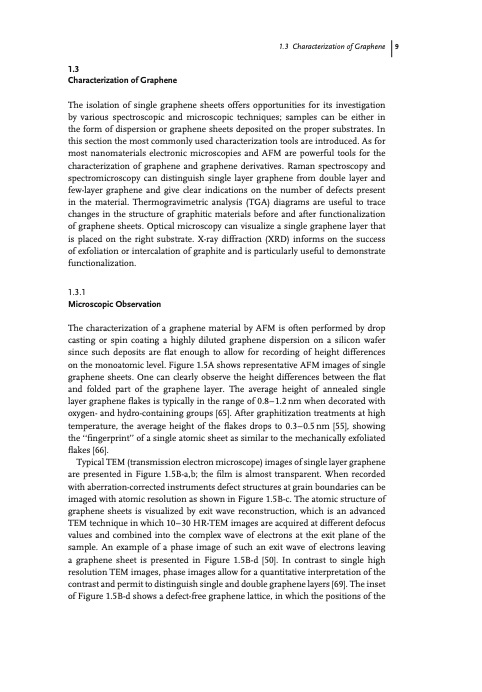
PDF Publication Title:
Text from PDF Page: 009
1.3 Characterization of Graphene The isolation of single graphene sheets offers opportunities for its investigation by various spectroscopic and microscopic techniques; samples can be either in the form of dispersion or graphene sheets deposited on the proper substrates. In this section the most commonly used characterization tools are introduced. As for most nanomaterials electronic microscopies and AFM are powerful tools for the characterization of graphene and graphene derivatives. Raman spectroscopy and spectromicroscopy can distinguish single layer graphene from double layer and few-layer graphene and give clear indications on the number of defects present in the material. Thermogravimetric analysis (TGA) diagrams are useful to trace changes in the structure of graphitic materials before and after functionalization of graphene sheets. Optical microscopy can visualize a single graphene layer that is placed on the right substrate. X-ray diffraction (XRD) informs on the success of exfoliation or intercalation of graphite and is particularly useful to demonstrate functionalization. 1.3.1 Microscopic Observation The characterization of a graphene material by AFM is often performed by drop casting or spin coating a highly diluted graphene dispersion on a silicon wafer since such deposits are flat enough to allow for recording of height differences on the monoatomic level. Figure 1.5A shows representative AFM images of single graphene sheets. One can clearly observe the height differences between the flat and folded part of the graphene layer. The average height of annealed single layer graphene flakes is typically in the range of 0.8–1.2nm when decorated with oxygen- and hydro-containing groups [65]. After graphitization treatments at high temperature, the average height of the flakes drops to 0.3–0.5nm [55], showing the ‘‘fingerprint’’ of a single atomic sheet as similar to the mechanically exfoliated flakes [66]. Typical TEM (transmission electron microscope) images of single layer graphene are presented in Figure 1.5B-a,b; the film is almost transparent. When recorded with aberration-corrected instruments defect structures at grain boundaries can be imaged with atomic resolution as shown in Figure 1.5B-c. The atomic structure of graphene sheets is visualized by exit wave reconstruction, which is an advanced TEM technique in which 10–30 HR-TEM images are acquired at different defocus values and combined into the complex wave of electrons at the exit plane of the sample. An example of a phase image of such an exit wave of electrons leaving a graphene sheet is presented in Figure 1.5B-d [50]. In contrast to single high resolution TEM images, phase images allow for a quantitative interpretation of the contrast and permit to distinguish single and double graphene layers [69]. The inset of Figure 1.5B-d shows a defect-free graphene lattice, in which the positions of the 1.3 Characterization of Graphene 9PDF Image | An Introduction to Graphene

PDF Search Title:
An Introduction to GrapheneOriginal File Name Searched:
352733551X-c01.pdfDIY PDF Search: Google It | Yahoo | Bing
Salgenx Redox Flow Battery Technology: Power up your energy storage game with Salgenx Salt Water Battery. With its advanced technology, the flow battery provides reliable, scalable, and sustainable energy storage for utility-scale projects. Upgrade to a Salgenx flow battery today and take control of your energy future.
| CONTACT TEL: 608-238-6001 Email: greg@infinityturbine.com | RSS | AMP |